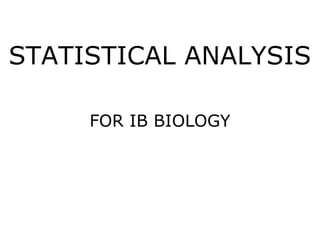
Calculating sd
- 1. STATISTICAL ANALYSIS FOR IB BIOLOGY
- 2. Median, mode, mean, range & standard deviation •The median is the middle value when the values are placed in order of size. •The mode is the most commonly occurring value, the value that appears the most times/shows the greatest frequency. •The mean is the sum of the values divided by the number of values. •The range is the difference between the minimum and the maximum value •The standard deviation is the measure of the spread of values around the mean.
- 3. The range or SD of data is shown as error bars on a graphical presentation
- 4. Calculating stats using the GDC Player A x 12 16 10 Finding standard deviation with a GDC: In the STAT mode enter the values into a list, in this case list1 20 22 17 15 (CALC) (SET) Ensure XList: List1 1Var Freq: 1 (1Var) x :16 ∑x ∑x :112 2 xσ n xσ n − 1 n :1898 : 3.89 Either these values : 4.20 will be accepted. :7 Player B x 7 9 12 31 22 22 9 Use a GDC to find the standard deviation for player B. x : .9 σ8 n3
- 5. What does the value for standard deviation tell you?
- 6. Two data sets can have the same mean value but different SDs
- 7. Comparing two sets of data: when is a difference significant and when is it not? •A difference is NOT regarded as significant when any differences are due to chance variation. •In statistics the assumption is initially made that any differences are due to chance. This is called the null hypothesis. •Where the null hypothesis is rejected, a difference is regarded as significant i.e. the differences are not just due to chance but to an actual factor causing the difference.
- 8. A simple rule to evaluate the significance of difference between two data sets: Significant difference unlikely if the standard deviations are greater than the difference between the means (left diagram) BUT likely if the standard deviations are smaller than the difference between the means (right diagram).
- 9. Example In a study of heights, two separate human populations were sampled: •Population A had a mean height of 1.65 m and population B a mean height of 1.72 m. •SD of population A was 0.09 m and SD of population B 0.1 m. •Evaluate the data to assess if there is likely to be a significant difference between the heights of the two populations.
- 10. Student’s t-test •A statistical test to find more reliably if there is a significant difference between two sets of normally distributed data with ten or more values. •You are not expected to calculate the value of t, but the calculation uses the difference between the means and the size of the standard deviations. •The test requires the calculation of degrees of freedom, d.f. = n1+n2-2 where n is the number of values. •A table of values is used to find the level of significance using the t value and degrees of freedom (use the one tailed test). •If the level of significance is 5% or below, reject the null hypothesis; if above it is accepted that the differences are due to chance i.e. no significant difference.
- 11. Example: a study to compare shell diameters in two different populations of Periwinkle (a marine mollusc). Use the data below to carry out a t-test to determine the level of significance. Population A Population B n (number in sample) = 15 n (number in sample) = 12 Mean shell diameter = 1.35 mm Mean shell diameter = 1.55 mm Standard deviation = 0.15 mm Standard deviation = 0.24 mm
- 12. Types of correlation (note the out-liers) v a r ia b le 1 N o C o r r e la tio n v a r ia b le 2 N e g a tiv e C o r r e la tio n v a r ia b le 2 v a r ia b le 2 P o s itiv e C o r r e la tio n v a r ia b le 1 v a r ia b le 1
- 13. Correlations and causal relationships •A causal relationship is one in which one factor/variable affects another e.g. the extension of a spring depends on the force applied; an increase in air humidity causes the transpiration rate to fall. •A positive or negative correlation implies a causal relationship but does not prove it. •Proof of a causal relationship in science often requires an experiment in which one variable is manipulated/changed (independent variable) and this is shown to affect another measured (dependent) variable.
- 14. Some examples •It was found that towns with a greater number of nesting storks had more children per household than towns with fewer storks (positive correlation). •CAN WE THEREFORE CONCLUDE THAT THE STORKS WERE DELIVERING THE BABIES? •It has long been known that there is a positive correlation between the number of cigarettes smoked and deaths from lung cancer. •ONLY RECENTLY HAS IT BEEN SHOWN THAT SMOKING CAUSES LUNG CANCER. •A strong correlation exists between rise in atmospheric CO2 levels and rise in global temperature. •SOME PEOPLE STILL DISPUTE THAT INCREASING CO2 LEVELS IS WHAT CAUSES GLOBAL WARMING